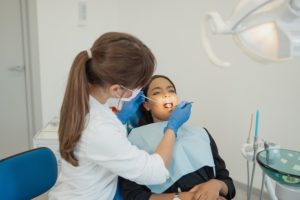TMJ Disorder Treatments in San Diego, CA
Ease Your Jaw Pain
If you suffer from temporomandibular joint disorder (TMD), you may be wondering what treatment will work best for you. For temporomandibular disorders, there are various treatment options to consider, both non-surgical and surgical. To find the best treatment for you, contact our San Diego, CA dentist, Dr. Purps, today by calling (858) 331-1256 to schedule a TMJ consultation and begin your journey to less facial pain.
What Are Temporomandibular Joint Disorders?
Temporomandibular joint disorders (TMJ disorders or TMD) are a group of conditions that affect the temporomandibular joint, which is the joint that connects your jawbone (mandible) to your skull (temporal bone) just in front of your ear. These disorders can cause pain and dysfunction in the jaw joint and the muscles that control jaw movement. TMJ disorders can range from mild to severe and can be temporary or chronic.
Surgical Treatment Options for TMD
Arthrocentesis
Arthrocentesis is a minimally invasive surgical procedure in which a small needle is inserted into the joint space to irrigate the joint and remove any debris or inflammatory substances. This procedure can help reduce pain and improve jaw function. This procedure can be performed on an outpatient basis, and most patients can return to normal activities within a few days of the procedure.
Arthroscopy
Arthroscopy is a minimally invasive surgical procedure that uses a small camera and surgical instruments to diagnose and treat joint problems. During an arthroscopy for TMJ, a small incision is made near the joint, and the camera is inserted to view the joint’s interior. This procedure can remove inflamed tissue or repair a torn disc. Your oral surgeon may also smooth out rough or uneven surfaces, reducing pain and improving jaw movement.
Open Joint Surgery
Open joint surgery is a more invasive surgical option for TMD, during which the jaw joint is opened to allow the surgeon better access to the joint’s interior. This procedure may be necessary for those with severe joint damage, such as advanced osteoarthritis or dislocated discs. The surgeon may remove damaged tissue, repair or replace the disc, or reposition the jaw during the surgery.
Total Joint Replacement
Total joint replacement involves replacing the entire joint with an artificial joint. This option is typically reserved for those with severe joint damage that cannot be repaired through other surgical methods. Your oral surgeon will remove the damaged joint and replace it with an artificial joint made of metal, plastic, or a combination of both. The artificial joint replicates the natural joint’s movement, allowing for improved jaw function and reduced pain.
When Is Surgery for TMD the Best Option?
When it comes to treating a temporomandibular joint disorder, surgery is usually a last resort after non-surgical options have been exhausted. However, there are situations where surgery for TMD may be the best option. Factors to consider include:
- Severe Joint Damage: If you have significant joint damage, such as advanced osteoarthritis or dislocated discs, surgery may be necessary to repair or replace the damaged tissue.
- Limited Jaw Movement: If TMD is causing limited jaw movement that affects your daily activities, surgery may be the best option to improve jaw function and quality of life, surgery may be necessary to correct the problem.
- Ineffective Non-Surgical Treatments: If you have tried non-surgical treatments, such as medications, physical therapy, and splints without finding relief from TMD symptoms, surgery may be the best option.
- Persistent Pain: Pain that affects your quality of life and isn’t relieved by non-surgical treatments may indicate that surgery is needed.
Holistic Treatment for TMJ Disorders
In most cases, healthcare professionals will recommend more conservative approaches to temporomandibular joint dysfunction before considering surgery. Various holistic treatment options may help relieve your jaw pain.
Acupuncture
Acupuncture is a traditional medicine technique that involves inserting thin needles into specific points of the body. It’s believed to help balance the body’s energy flow and stimulate the natural healing processes. Acupuncture can be an effective holistic treatment for TMJ disorders by relieving chronic pain, and reducing inflammation. Some patients may experience immediate relief from TMJ symptoms after just one acupuncture session, while others may require several sessions to see improvement.
Chiropractic Care
Chiropractic care involves manipulating the spine to improve alignment and relieve tension. It can help reduce pain and improve joint mobility, making it a potential holistic treatment for TMJ disorders. Chiropractors may use spinal adjustments, soft tissue therapy, and exercises to improve TMJ symptoms. It’s crucial to note that chiropractic care may not be suitable for everyone. Consult with your doctor before starting any new treatment.
Massage Therapy
Massage therapy can help relieve muscle tension and reduce pain, making it a potential holistic treatment for TMJ disorders. A massage therapist may use techniques such as deep tissue massage, trigger point therapy, and myofascial release to help release tension in the jaw muscles and promote relaxation. Regular massage therapy sessions can also help improve circulation and reduce stress levels to promote overall wellness.
Essential Oils
Certain essential oils have anti-inflammatory and analgesic properties that can help relieve TMJ pain and swelling. Lavender and peppermint are two essential oils that are particularly effective. Mix a few drops of essential oil with coconut or olive oil and massage it into the affected area. Alternatively, add a few drops of essential oil to a warm bath and soak it for 15 to 20 minutes to help relax the muscles and alleviate pain.
Herbal Supplements
Certain herbs have natural anti-inflammatory properties that can help reduce pain and swelling associated with TMJ disorders. You can take these herbs in supplement form or incorporate them into your diet by adding them to your meals or drinking them as tea. Ginger can also be applied topically as a poultice to the affected area to help relieve pain and inflammation. Consult with your doctor before taking any herbal supplements, as they may interact with other medications or have side effects.
Lifestyle Changes to Ease TMD Pain
You may find pain relief by managing the following:
- Diet: Eating a healthy, balanced diet can help reduce inflammation in the body, including inflammation in the jaw muscles and joints that can cause TMJ pain. Some anti-inflammatory foods to include in your diet are leafy greens, berries, nuts, fatty fish, and whole grains. You may try avoiding or limiting processed foods, sugar, and alcohol, as they can increase inflammation in the body and worsen symptoms.
- Stress Management: Stress is a common trigger for TMJ disorders and it can worsen symptoms. Practicing relaxation techniques such as yoga, meditation, and deep breathing can help reduce stress and promote relaxation. Regular exercise, spending time outdoors, and engaging in hobbies or activities that you enjoy can also help reduce stress levels.
- Sleep: Getting enough can help reduce stress levels and promote relaxation to improve TMD symptoms. Aim to get seven to eight hours of sleep each night and establish a regular sleep schedule by going to bed and waking up at the same time each day. Avoid using electronic devices before bed and create a relaxing bedtime routine, such as taking a warm bath or reading a book, to help prepare your body and mind for sleep.
- Warm and Cold Compresses: Applying a warm compress or cold pack to the affected area can help alleviate TMJ symptoms and reduce inflammation. A warm compress helps increase blood flow and relax the muscles, while a cold compress helps numb the pain and reduce swelling.
Frequently Asked Questions
What causes TMJ to flare up?
Temporomandibular joint (TMJ) flare-ups can occur due to various factors. These triggers can include stress, teeth grinding (bruxism), poor posture, traumatic injury to the jaw or head, arthritis affecting the TMJ, dental issues such as bite problems, and chronic habits like nail-biting or excessive gum chewing. Changes in diet, hormonal fluctuations, and excessive jaw movement through activities like talking or playing musical instruments can also contribute to TMJ flare-ups.
What are the risks associated with TMD surgery?
As with any surgery, there are risks associated with TMD surgery. These can include bleeding, infection, nerve damage, and damage to surrounding tissues. Your doctor will discuss these risks with you and take steps to minimize them. Follow all pre-operative and post-operative instructions carefully to reduce the risk of complications.
How can I prepare for TMD surgery?
Preparing for TMD surgery will depend on the specific procedure. Your doctor will provide detailed instructions on preparing for your surgery, including fasting instructions and medication guidelines. You may need to arrange for transportation to and from the hospital, and you may need to take time off work or other obligations to allow for proper recovery.
Start your Journey to a Life Without Jaw Pain
If you’re experiencing symptoms of TMD and have not found relief, it may be time to consider your treatment options. Don’t let TMD symptoms continue to impact your daily life — take action and explore your treatment options today.
Contact Fine Dentistry today at (858) 331-1256 to explore our comprehensive TMD treatment options tailored to your well-being. We welcome patients from Chula Vista, Lincoln Heights, and Mission Hills, CA.
